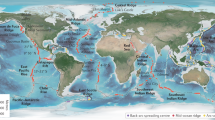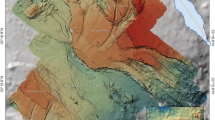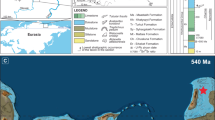Abstract
Hydrothermal systems, where geothermally heated water discharges through a planet’s crust, occur on land or underwater. Hydrothermal systems have been proposed as environments that could support the emergence of life, with particular attention given to deep-sea vents and on-land hot springs. We propose that alkaline hydrothermal vents in shallow waters (<200 m depth), high-energy environments that display diverse and variable geochemistry, should also be considered in origin-of-life scenarios for the early Earth. Two active alkaline shallow vents—the Strytan Hydrothermal Field in Iceland and the Prony Hydrothermal Field in New Caledonia—provide examples of the conditions found in shallow-sea vents that may be relevant for facilitating prebiotic chemical reactions. These conditions include wet–dry cycling, temperature variations, and influxes of both saltwater and freshwater. We argue that the spatial and temporal geochemical variability in shallow-vent hydrothermal systems can support a range of prebiotic chemical reactions required for the emergence of life.
This is a preview of subscription content, access via your institution
Access options
Access Nature and 54 other Nature Portfolio journals
Get Nature+, our best-value online-access subscription
$29.99 / 30 days
cancel any time
Subscribe to this journal
Receive 12 print issues and online access
$259.00 per year
only $21.58 per issue
Buy this article
- Purchase on Springer Link
- Instant access to full article PDF
Prices may be subject to local taxes which are calculated during checkout



Similar content being viewed by others
References
Russell, M. J. & Hall, A. J. In Evolution of Early Earth’s Atmosphere,Hydrosphere, and Biosphere—Constraints from Ore Deposits (eds Kesler, S. and Ohmoto, H.) (Geological Society of America Memoir, 2006)
Martin, W., Baross, J., Kelley, D. & Russell, M. J. Hydrothermal vents and the origin of life. Nat. Rev. Microbiol. 6, 806–814 (2008).
Kelley, D. S. et al. An off-axis hydrothermal vent field near the Mid-Atlantic Ridge at 30° N. Nature 412, 145–149 (2001).
Price, R. et al. Alkaline vents and steep Na+ gradients from ridge-flank basalts—implications for the origin and evolution of life. Geology 45, 1135–1138 (2017).
Russell, M. J. Green rust: the simple organizing ‘seed’ of all life? Life 8, 35 (2018).
Damer, B. & Deamer, D. The hot spring hypothesis for an origin of life. Astrobiology 20, 429–452 (2020).
Mulkidjanian, A. Y., Bychkov, A. Y., Dibrova, D. V., Galperin, M. Y. & Koonin, E. V. Origin of first cells at terrestrial, anoxic geothermal fields. Proc. Natl Acad. Sci. USA 109, E821–E830 (2012).
Deamer, D., Damer, B. & Kompanichenko, V. Hydrothermal chemistry and the origin of cellular life. Astrobiology 19, 1523–1537 (2019).
Russell, M. J. The ‘water problem’(sic), the illusory pond and life’s submarine emergence—a review. Life 11, 429 (2021).
Price, R. E. & Giovannelli, D. A Review of the Geochemistry and Microbiology of Marine Shallow-Water Hydrothermal Vents (Reference Module in Earth Systems and Environmental Sciences, Elsevier, 2017).
Beaulieu, S. E. & Szafrański, K. M. InterRidge Global Database of Active Submarine Hydrothermal Vent Fields Version 3.4 (PANGAEA, accessed 7 February 2021); https://doi.pangaea.de/10.1594/PANGAEA.917894
Yücel, M. et al. Eco-geochemical dynamics of a shallow-water hydrothermal vent system at Milos Island, Aegean Sea (eastern Mediterranean). Chem. Geol. 356, 11–20 (2013).
Valsami-Jones, E. et al. The geochemistry of fluids from an active shallow submarine hydrothermal system: Milos Island, Hellenic Volcanic Arc. J. Volcanol. Geotherm. Res. 148, 130–151 (2005).
Marteinsson, V. T. et al. Discovery and description of giant submarine smectite cones on the seafloor in Eyjafjordur, northern Iceland, and a novel thermal microbial habitat. Appl. Environ. Microbiol. 67, 827–833 (2001).
Rempfert, K. R. et al. Geological and geochemical controls on subsurface microbial life in the Samail Ophiolite, Oman. Front. Microbiol. 8, 56 (2017).
Monnin, C. et al. Fluid chemistry of the low temperature hyperalkaline hydrothermal system of Prony Bay (New Caledonia). Biogeosciences 11, 5687–5706 (2014).
Garnier, J. Voyage Autour du Monde, La Nouvelle-Calédonie (Côte Orientale) (Plon, 1871).
Barnes, S. J. & Arndt, N. T. in Earth’s Oldest Rocks 2nd edn (eds van Kranendonk, M. et al.) 103–132 (Elsevier, 2019).
Miyazaki, Y. & Korenaga, J. A wet heterogeneous mantle creates a habitable world in the Hadean. Nature 603, 86–90 (2022).
Rosas, J. C. & Korenaga, J. Archaean seafloors shallowed with age due to radiogenic heating in the mantle. Nat. Geosci. 14, 51–56 (2021).
Banks, D. & Frengstad, B. Evolution of groundwater chemical composition by plagioclase hydrolysis in Norwegian anorthosites. Geochim. Cosmochim. Acta 70, 1337–1355 (2006).
Macleod, G., McKeown, C., Hall, A. J. & Russell, M. J. Hydrothermal and oceanic pH conditions of possible relevance to the origin of life. Orig. Life Evol. Biosph. 24, 19–41 (1994).
Ueda, H. et al. Chemical nature of hydrothermal fluids generated by serpentinization and carbonation of komatiite: implications for H2-rich hydrothermal system and ocean chemistry in the early Earth. Geochem. Geophys. Geosyst. 22, e2021GC009827 (2021).
Nie, N. X. et al. Iron and oxygen isotope fractionation during iron UV photo-oxidation: implications for early Earth and Mars. Earth Planet. Sci. Lett. 458, 179–191 (2017).
Konhauser, K. O. et al. Decoupling photochemical Fe(II) oxidation from shallow-water BIF deposition. Earth Planet. Sci. Lett. 258, 87–100 (2007).
Tosca, N. J., Guggenheim, S. & Pufahl, P. K. An authigenic origin for Precambrian greenalite: implications for iron formation and the chemistry of ancient seawater. Geol. Soc. Am. Bull. 128, 511–530 (2016).
Wong, M. L., Charnay, B. D., Gao, P., Yung, Y. L. & Russell, M. J. Nitrogen oxides in early Earth’s atmosphere as electron acceptors for life’s emergence. Astrobiology 17, 975–983 (2017).
Ranjan, S., Todd, Z. R., Rimmer, P. B., Sasselov, D. D. & Babbin, A. R. Nitrogen oxide concentrations in natural waters on early Earth. Geochem. Geophys. Geosyst. 20, 2021–2039 (2019).
Nishizawa, M. et al. Stable abiotic production of ammonia from nitrate in komatiite‐hosted hydrothermal systems in the Hadean and Archean oceans. Minerals 11, 321 (2021).
Hansen, H. C. B., Guldberg, S., Erbs, M. & Koch, C. B. Kinetics of nitrate reduction by green rusts—effects of interlayer anion and Fe(II):Fe(III) ratio. Appl. Clay Sci. 18, 81–91 (2001).
Monnard, P.-E., Apel, C. L., Kanavarioti, A. & Deamer, D. Influence of ionic inorganic solutes on self-assembly and polymerization processes related to early forms of life: implications for a prebiotic aqueous medium. Astrobiology 2, 139–152 (2002).
Maurer, S. E. & Nguyen, G. Prebiotic vesicle formation and the necessity of salts. Orig. Life Evol. Biosph. 46, 215–222 (2016).
Milshteyn, D., Damer, B., Havig, J. & Deamer, D. Amphiphilic compounds assemble into membranous vesicles in hydrothermal hot spring water but not in seawater. Life 8, E11 (2018).
Novikov, Y. & Copley, S. D. Reactivity landscape of pyruvate under simulated hydrothermal vent conditions. Proc. Natl Acad. Sci. USA 110, 13283–13288 (2013).
Roldan, A. et al. Bio-inspired CO2 conversion by iron sulfide catalysts under sustainable conditions. Chem. Commun. 51, 7501 (2015).
Barge, L. M., Flores, E., Baum, M. M., VanderVelde, D. & Russell, M. J. Redox and pH gradients drive amino acid synthesis in iron oxyhydroxide mineral systems. Proc. Natl Acad. Sci. USA 116, 4828–4833 (2019).
Muchowska, K. B. et al. Metals promote sequences of the reverse Krebs cycle. Nat. Ecol. Evol. 1, 1716–1721 (2017).
Guzman, M. I. & Martin, S. T. Prebiotic metabolism: production by mineral photoelectrochemistry of α-ketocarboxylic acids in the reductive tricarboxylic acid cycle. Astrobiology 9, 833–842 (2009).
Bonfio, C. et al. UV-light-driven prebiotic synthesis of iron–sulfur clusters. Nat. Chem. 9, 1229–1234 (2017).
Zhang, X. V. & Martin, S. T. Driving parts of Krebs cycle in reverse through mineral photochemistry. J. Am. Chem. Soc. 128, 16032–16033 (2006).
Forsythe, J. G. et al. Surveying the sequence diversity of model prebiotic peptides by mass spectrometry. Proc. Natl Acad. Sci. USA 114, E7652–E7659 (2017).
Frenkel-Pinter, M. et al. Selective incorporation of proteinaceous over nonproteinaceous cationic amino acids in model prebiotic oligomerization reactions. Proc. Natl Acad. Sci. USA 116, 16338–16346 (2019).
Lathe, R. Fast tidal cycling and the origin of life. Icarus 168, 18–22 (2004).
Lathe, R. Early tides: response to Varga et al. Icarus 180, 277–280 (2006).
Ranjan, S. et al. UV transmission in natural waters on prebiotic Earth. Astrobiology 22, 242–258 (2022).
Green, N. J., Xu, J. & Sutherland, J. D. Illuminating life’s origins: UV photochemistry in abiotic synthesis of biomolecules. J. Am. Chem. Soc. 143, 7219–7236 (2021).
Michalski, J. R., Dobrea, E. Z. N., Niles, P. B. & Cuadros, J. Ancient hydrothermal seafloor deposits in Eridania basin on Mars. Nat. Commun. 8, 15978 (2017).
Tarnas, J. D. et al. Characteristics, origins, and biosignature preservation potential of carbonate-bearing rocks within and outside of Jezero crater. J. Geophys. Res. Planets 126, e2021JE006898 (2021).
Launay, J. & Fontes, J.-C. Les sources thermales de Prony (Nouvelle-Calédonie) et leurs précipités chimiques. Exemple de formation de brucite primaire. Géol. de la France 1, 83–100 (1985).
Acknowledgements
We thank L. Rodriguez for very helpful comments on this manuscript. L.M.B.’s work was carried out at the NASA Jet Propulsion Laboratory, California Institute of Technology, under a contract with NASA. L.M.B. and R.E.P. were supported by NASA Habitable Worlds, grant no. 80NSSC20K0228 and NASA PSTAR, grant no. 80NSSC18K1651. L.M.B. was also supported by the NASA-NSF Ideas Lab for the Origins of Life. R.E.P. also received support from the Hanse-Wissenschaftskolleg Institute for Advanced Study, Delmenhorst, Germany. R.E.P. thanks the HydroProny research group for valuable collaboration and insights related to Prony.
Author information
Authors and Affiliations
Contributions
R.E.P. conducted field work at hydrothermal sites. L.M.B. and R.E.P wrote the paper.
Corresponding author
Ethics declarations
Competing interests
The authors declare no competing interests.
Peer review
Peer review information
Primary handling editor: Tamara Goldin, in collaboration with the Nature Geoscience team.
Additional information
Publisher’s note Springer Nature remains neutral with regard to jurisdictional claims in published maps and institutional affiliations.
Rights and permissions
Springer Nature or its licensor (e.g. a society or other partner) holds exclusive rights to this article under a publishing agreement with the author(s) or other rightsholder(s); author self-archiving of the accepted manuscript version of this article is solely governed by the terms of such publishing agreement and applicable law.
About this article
Cite this article
Barge, L.M., Price, R.E. Diverse geochemical conditions for prebiotic chemistry in shallow-sea alkaline hydrothermal vents. Nat. Geosci. 15, 976–981 (2022). https://doi.org/10.1038/s41561-022-01067-1
Received:
Accepted:
Published:
Issue Date:
DOI: https://doi.org/10.1038/s41561-022-01067-1
This article is cited by
-
Magnesium silicate chimneys at the Strytan hydrothermal field, Iceland, as analogues for prebiotic chemistry at alkaline submarine hydrothermal vents on the early Earth
Progress in Earth and Planetary Science (2024)
-
Generation of long-chain fatty acids by hydrogen-driven bicarbonate reduction in ancient alkaline hydrothermal vents
Communications Earth & Environment (2024)



